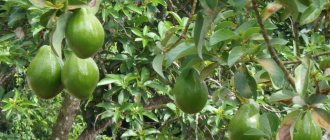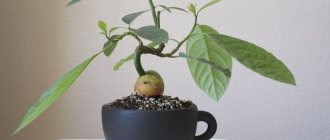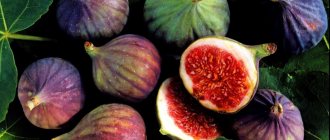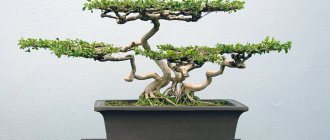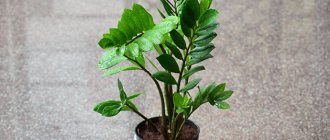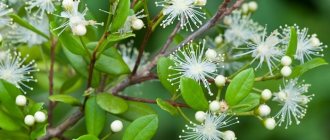Since ancient times, people have been familiar with such an evergreen fruit plant as the avocado tree. Thanks to its oily, pear-shaped fruits, it is also called alligator pear, agacat, and American persea. Today, many people want to grow such a miracle fruit at home, but to do this you need to know some secrets for caring for it.
What does an avocado tree look like?
In nature, an adult avocado tree, which belongs to the laurel family, grows up to 20 m. It has a wide crown, a trunk up to 60 cm in diameter, sharp leathery leaves with a shiny dark green upper surface and whitish lower surface. Sometimes a tree sheds its leaves, but then grows them back. It is found in tropical and subtropical regions of India, America, and Africa. The avocado fruit is a large, single-seeded, dark green berry, shaped like a pear.
An adult avocado tree whose flowering does not look very attractive can be grown at home. Its inconspicuous flowers have a greenish tint. They bloom twice a season. Initially, their stamens are pollinated by pollen from other trees, and after about a day the anthers ripen and insects transfer their pollen to other plants. Experienced gardeners recommend planting several avocado trees nearby, whose flowering times overlap.
Many novice gardeners are interested in what an avocado tree looks like at home. This exotic plant can be grown at home on a windowsill. However, its height does not exceed 2.5 m. Often its growth is limited by the size of the pot. In areas with a warm climate in the summer, the plant can be taken outside, avoiding drafts. Avocado fruits at home grow smaller in size compared to garden specimens.
Problems
Avocado trees at home are quite sensitive to various fungal or viral diseases. If the conditions of maintenance are violated, you can immediately find out about this by the state of the plant. If the leaves dry out and begin to darken for no apparent reason, it means that the roots of the plant were damaged during the next replanting. If exposed to bright sunlight, a burn may occur.
Sunburn on leaves
Yellowing of the foliage and falling of the lower leaves means that the plant is suffering from disease from excess moisture. From lack of watering, the leaves can dry out and curl.
Also, plants are sometimes attacked by spider mites, aphids, and whiteflies. You can get rid of them using insecticides.
If you decide to plant an avocado indoor plant, then you need to study this issue in detail. With proper care, wood will not only please the eye, but also purify the air. And also sometimes give the family healthy and tasty fruits.
Planting avocados at home
Do you love exotic plants and would like to grow avocados at home? Then you need to find out everything about this tree: how to plant and care for an avocado, whether it can bloom at home and bear fruit. Only after this, having gained patience and armed with the necessary knowledge, can you begin the long process of growing this unusual alligator pear. An avocado tree can be grown at home on a windowsill, in a heated greenhouse or in a winter garden.
How to prepare an avocado seed for planting?
To grow an avocado tree at home, you must first select a ripe fruit. You can buy it in the store, but first check the selected avocado for ripeness: hold it between your palms, squeeze lightly and release. A ripe fruit will quickly restore its original shape. This means that it is ripe and you can safely buy it. You can also buy an unripe avocado, but before removing the pit from it, you need to let it ripen among bananas and apples, which emit ethylene gas, which accelerates the ripening of the fruit.
Cut the ripe fruit in half lengthwise and carefully remove the seed using a spoon. We thoroughly rinse it to remove any remaining pulp. There are three ways to plant an avocado seed:
- We stick toothpicks 3 mm deep into the cleaned bone on three sides, and place it with the blunt side in a glass of water. In this case, you need to make sure that only the bottom of the bone is in the water, and the puncture sites are above the water.
- We plant the peeled seed immediately in a pot of soil, leaving a third part above the surface. Its blunt end should be buried in the ground. We water once a week.
- Peel the avocado pit and immerse two-thirds of it in water. It will grow faster, and through the glass you will be able to watch the roots and stem grow.
Water for germination must be settled. You can add activated or charcoal to it. As it evaporates, water must be added. It is better to choose a large bone, which contains more nutrients. It can germinate in different periods - from a week to two months. The best time for this is spring. After the seed cracks and splits into cotyledons, roots appear from it and soon it can be transplanted into the ground.
Avocado pot
To plant an avocado seed, it is better to choose a plastic pot with a diameter of 9-15 cm and a height of about 15 cm. The container must have drainage holes to drain excess water. As soon as the sprout grows 3 cm, it is transplanted into a pot. We pour a 2 cm layer of drainage onto the bottom of the container. We make a small depression in the ground, into which we plant the sprouted seed so that its third part is above the surface of the soil.
The sprout grows very quickly at first. The avocado tree is heat-loving; growing it at home largely depends on the temperature regime. In cool summer weather, you should not take the pot with the plant outside. In winter, when the temperature drops below +10ºС, the tree can shed its leaves, and new ones will grow only in the spring.
Avocado soil
This crop does not grow well in heavy, clayey, acidic soil, so for planting it is better to prepare in advance an earthen mixture consisting of peat, coarse sand, humus and garden soil in equal parts. You can add a pinch of lime here. The day before planting the seeds, boiling water should be poured onto the ground to disinfect it. In such a soil mixture you can grow an avocado tree from a seed.
Is it possible to grow avocados yourself?
An exotic crop, the fruits of which we often see on supermarket shelves, most avid gardeners would like to cultivate on their own property. However, a heat-loving tropical plant that is not adapted to cold winters will die at the first frost.
The only way to add a rare specimen to your plant collection is to grow it indoors. If you have the opportunity to get an avocado branch from someone's private greenhouse, you should keep in mind that this plant does not lend itself well to cuttings.
The easiest way to propagate American Persea is by rooting the fruit seed. Even novice gardeners and indoor plant lovers can cope with this task.
Planting avocados outside
In areas with a temperate climate, you can plant an avocado tree in a special hole, which will protect the plant from freezing in winter. To do this, in a sunny area, you need to dig a trench 1.5 m deep and 1.2 m wide. The fertile top layer of soil is thrown in one direction, and the rest of the soil extracted when digging the trench is thrown in the other. The wall on the north side is made vertical and sheathed with plywood or brick. The opposite slope is made flat and covered with black film.
A drainage layer in the form of pebbles, crushed stone or gravel is laid at the bottom of the pit. The excavated top soil is poured on top of it and a plant is planted in the trench, and a polycarbonate shelter is made on top. In such a shelter, an exotic avocado tree can comfortably overwinter. Those who live in the southern coastal areas can try to grow avocados in open ground.
Where is the best place to plant an avocado?
For planting avocados, an excellent option would be a place protected from cold northern winds, for example, gentle coastal southwestern and southeastern slopes. Areas with high humidity, where cold air can stagnate in winter, are not suitable for growing trees. A large avocado tree will do well in the company of another similar species, but single plantings are also possible.
What to do to make an avocado bear fruit
Even if a tree develops quickly, it is unlikely to bear fruit in an apartment. The only way to stimulate the process is to graft into the cleft. The scion is taken from a fruit-bearing tree. After the graft is accepted and begins to grow, the first fruits will appear in 5-6 years.
Attention! In indoor conditions, a tree without grafting will not bloom.
How to care for an avocado tree?
To grow an avocado tree at home, you need to provide it with careful care. This plant loves light, but will develop normally in partial shade. In summer, it should be shaded from the bright rays of the sun, and the best option would be to place a pot of avocado on a western window. The tree does not tolerate sudden temperature fluctuations, and in a draft it can lose all its leaves. The same can happen when the room temperature drops to +12ºС and below.
The street avocado tree is replanted once every three years. If you decide to leave the avocado tree outside in winter, then it must be carefully insulated using any covering material. When grown in a greenhouse, it must be provided with additional heating, and the trunks must be wrapped in foam rubber. It happens that a tree blooms in winter, but the buds cannot withstand the cold and fall off, although with the arrival of spring, flowering will occur on time.
How to pinch an avocado tree?
To make the avocado a real decoration of the room, you can initially plant three plants in one pot. As they grow, their flexible branches can be intertwined with each other in a pigtail. To form a lush, beautiful crown, the tree must be pinched. This is done after eight leaves appear on the stem. As a result, the side shoots of the plant will begin to grow, and as soon as they grow, their tops also need to be pinched. This is how you can get an adult avocado tree grown indoors.
How to water an avocado?
When growing avocados at home, you need to monitor the air humidity, which should be at least 70%. To maintain it, you can spray the plants with a spray bottle. In summer, an avocado tree in a pot should be watered generously; in winter, watering should be reduced. It is better to follow this rule: the warmer the air in the room, the more frequent and abundant the watering should be. This plant is especially sensitive to both drought and overwatering because its roots do not have small root hairs. During prolonged drought, the tree stops growing, sheds leaves and even fruits.
How to fertilize avocados?
When growing avocados at home, they are fed only during the period of active growth, in the spring and summer. Do this once every 2-3 weeks, using a special organic fertilizer for avocados or a balanced fertilizer for citrus fruits. In autumn and winter, the plant does not need supplements. Before fertilizing your home avocado tree, you should carefully study the instructions for using fertilizers.
How to shape an avocado tree?
For fast and uniform growth, a mature avocado tree must be pruned. It is better to do this in early spring or autumn, after harvesting. The work should be carried out very carefully, since the branches of the tree are brittle and can be easily damaged. The side shoots are cut off by about half, this should stimulate branching of the plant. On trees, all dry, damaged branches and those that grow into the middle of the tree are removed, thereby thickening its crown and preventing air exchange.
Avocado diseases and pests
The exotic avocado tree in the country and indoors can be affected by various pathogens and insect pests. Avocados that are grown in home conditions different from natural ones become especially vulnerable in this regard. The following diseases and pests are especially dangerous for this plant:
- Late blight
. The roots are affected first, then the trunk and bark of the tree. It is impossible to cure the plant; you just have to destroy it. - Powdery mildew
. A fungal disease affects the leaves and trunk of avocados. First, a plaque appears on the affected plant, and then yellow-green dried spots. Control measures: spray with fungicide. - Shield
. Settles on leaves and stems. To get rid of them, you need to wash the affected parts of the tree with a soapy solution. A large tree is treated with insecticides.
Avocado flowers and fruits
Cypress in a pot - how to care for it at home
The domestic avocado tree blooms with dim, small flowers. The first flowers appear 5-6 years after planting. Avocados grown at home are extremely reluctant to bloom. The buds form small and dim inflorescences of 7-10 flowers. They do not emit aroma and look unpretentious.
Avocado flowers
It is even more difficult to achieve its fruiting. Self-pollination at home is an extremely difficult procedure. The inflorescences on one flower bloom twice: on the first day - female, on the second - male. In order to properly and productively pollinate an avocado, it is necessary to select several of the strongest buds on the first day of flowering and mark them. The next day, even more flowers will open, and it becomes difficult to identify those that opened the day before. That's what the label is for.
Pollen is collected from a marked flower using a brush and transferred to neighboring flowers. On the second day, the number of flowers doubles, and it is not possible to visually determine which flower is the first and which the second. As a result, pollen also falls equally on male and female flowers.
Important! Even if male pollen gets on a female flower, there is no absolute guarantee that fruit will appear.
Pests and diseases
Avocados grown from the seed may dry out or lose their leaves. The reason for this condition may lie in high air temperatures. This condition is also observed at low temperatures. Watering affects the condition of the plant; it can be excessive or insufficient. Homemade avocados suffer from drafts. Therefore, the pot with the plant should be placed in a place protected from drafts.
Avocado diseases
If the tips of the foliage turn brown or the leaves fall off, then the air in the room is dry. The situation is corrected by regularly spraying the plant with a spray bottle. A similar situation occurs when homemade avocados experience a water shortage. Proper watering will correct the situation.
Central heating can also harm the flower. To make the plant suffer less from dry air, the pot is placed on a tray with sphagnum moss or moistened expanded clay.
When the leaves lose their brightness and become pale, it means the plant is receiving little light. The avocado should be moved closer to the window or provided with lighting.
Indoor avocado can damage:
- spider mite;
- scale insect;
- powdery mildew.
You can get rid of pests with a soap solution, treating problem areas or using insecticides such as Aktara, Fitoferm, Actellik, Biotlin, Calypso, Confidor.
Insecticides should be used as a last resort and only in case of severe damage.
Feeding
When the tree is one year old, you can start feeding it: during the year, mineral fertilizers are applied to it 4 times. In general, all feeding occurs in spring and summer, and is done once or twice a month. When feeding mature trees, the amount of nitrogen needed by the plant is increased and applied twice - at the beginning of summer and at the end of winter.
Sometimes it happens that on an adult plant the leaves begin to turn yellow. This is a sign that it lacks iron and zinc. To prevent this, the plant should be sprayed with iron chelate and fertilized with mixtures that contain a lot of zinc and iron.
Where is the best place to grow avocados?
Before choosing a flowerpot with a young bush for permanent residence, it is worth considering that avocados do not tolerate direct sunlight - they cause burns on the leaves. But otherwise it is quite unpretentious and grows well even in partial shade, although it prefers good, but diffused, lighting.
You can put the flowerpot on the northern window sill: there will be enough sun for avocados in the summer, and in the autumn-winter period you can simply install additional lighting.
As for air temperature and humidity, the evergreen bush needs warmth, but is able to winter in an unheated room with a temperature of at least 5 degrees Celsius, however, in this case it turns into a deciduous plant and sheds its leaves.
Possible problems and ways to solve them
Excess or lack of moisture, excessive use of fertilizers lead to problems. You can tell that a plant is uncomfortable by looking at its crown. Yellowed leaves with dry tips indicate a lack of moisture in the soil or that the plant is too hot. In this case, the tree is watered and sprayed with a spray bottle.
Fallen leaves indicate that the plant is cold or is standing in a draft. The room where exotic crops grow needs to be ventilated daily. But staying in the cold for a long time will destroy the plant.
Insufficient light or nutrient deficiency may cause leaves to turn pale. This care mistake is easy to correct. If it is not possible to move the plant to a brighter place, you need to organize additional lighting and add fertilizer to the soil.
Diseases and pests
Improper care provokes the development of diseases. In addition, weakened plants are often attacked by harmful insects.
The most common diseases of American persea are powdery mildew, late blight and root rot. These dangerous fungal infections spread very quickly, including to neighboring crops. The infected plant must be isolated and treated with fungicides “Topaz”, “Strobi”, “Tiovit Jet”. The soil in the pot must be replaced, and the affected fragments must be cut off and burned.
Among the pests, indoor avocados are most often affected by scale insects and spider mites. Insects that feed on plant cell sap can cause great harm. To combat them, the drugs “Aktara”, “Aktellik”, “Phosbecid”, etc. are used.
Interesting things on the site:
How to grow chestnuts from nuts at home
How to grow mangoes from seeds at home
How to water and feed?
In the summer, avocados should be watered frequently and sprayed regularly. In winter, the frequency of watering depends on the wintering conditions: the lower the temperature, the less often the bush is watered.
The avocado itself grows quickly, so it does not need frequent feeding, but it should be taken into account that the tree has a limited amount of soil in the pot and the nutrients there quickly run out. To replenish them, complex mineral preparations must be applied from spring to the end of summer (but not more than 2 times a month).
Which side to plant an avocado seed?
It is worth noting that it is not enough to simply immerse the seed in the ground and water it. Because the peel is quite strong and does not break easily. Therefore, the ideal option is to drill small holes in the bark, insert toothpicks into them, and immerse the avocado pit with the blunt side down. You can simply put a bone at the bottom of the glass and wait for it to hatch.
Avocados need to be planted in the soil with the blunt side down, this is where the sprout is located, which will quickly emerge and break through the shell of the pit.
Growing avocado from seed
